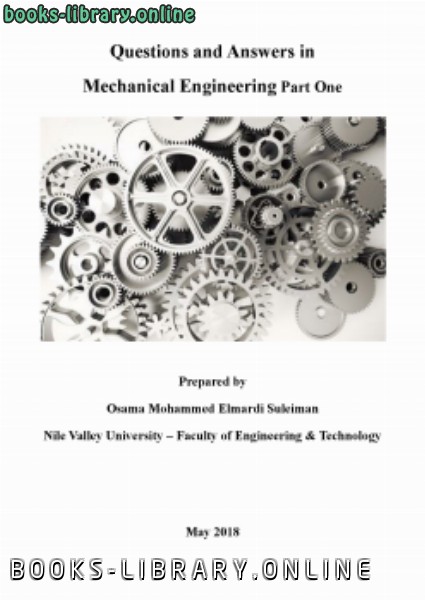📘 قراءة كتاب Questions and Answers in Mechanical Engineering Part One أونلاين


Questions and Answers in Mechanical Engineering Part One
Prepared by Osama Mohammed Elmardi Suleiman Nile Valley University – Faculty of Engineering & Technology
Question One What are Mechanical Properties of Material which every Mechanical Engineer Should Know? Mechanical properties of material: There are mainly two types of materials. First one is metal and other one is nonmetals. Metals are classified into two types: Ferrous metals and Non-ferrous metals. Ferrous metals mainly consist iron with comparatively small addition of other materials. It includes iron and its alloy such as cast iron, steel, HSS etc. Ferrous metals are widely used in mechanical industries for its various advantages. Nonferrous metals contain little or no iron. It includes aluminum, magnesium, copper, zinc etc. Most Mechanical Properties are associated with metals these are- #1. Strength: The ability of material to withstand load without failure is known as strength. If a material can bear more load, it means it has more strength. Strength of any material mainly depends on type of loading and deformation before fracture. According to loading types, strength can be classified into three types. 1. Tensile strength: 2. Compressive strength: 3. Shear strength: According to the deformation before fracture, strength can be classified into three types. 1. Elastic strength: 2. Yield strength: 3. Ultimate strength: #2. Homogeneity:
2
If a material has same properties throughout its geometry, known as homogeneous material and the property is known as homogeneity. It is an ideal situation but practically no material is homogeneous. #3. Isotropy: A material which has same elastic properties along its all loading direction known as isotropic material. #4. Anisotropy: A material which exhibits different elastic properties in different loading direction known as an-isotropic material. #5. Elasticity: If a material regains its original dimension after removal of load, it is known as elastic material and the property by virtue of which it regains its original shape is known as elasticity. Every material possesses some elasticity. It is measure as the ratio of stress to strain under elastic limit. #6. Plasticity: The ability of material to undergo some degree of permanent deformation without failure after removal of load is known as plasticity. This property is used for shaping material by metal working. It is mainly depending on temperature and elastic strength of material. #7. Ductility: Ductility is a property by virtue of which metal can be drawn into wires. It can also define as a property which permits permanent deformation before fracture under tensile loading. The amount of permanent deformation (measure in percentage elongation) decides either the material is ductile or not. Percentage elongation = (Final Gauge Length – Original Gauge Length) *100/ Original Gauge Length If the percentage elongation is greater than 5% in a gauge length 50 mm, the material is ductile and if it less than 5% it is not.
mechanical engineering questions and answers pdf
mechanical engineering interview questions and answers for freshers pdf
basic mechanical engineering interview questions and answers
basic mechanical engineering pdf
indiabix engineering
computer engineering question
thermodynamics questions and answers pdf
indiabix interview questions
حجم الكتاب عند التحميل : 2.7 ميجا بايت .
نوع الكتاب : pdf.
عداد القراءة:
اذا اعجبك الكتاب فضلاً اضغط على أعجبني و يمكنك تحميله من هنا:

شكرًا لمساهمتكم
شكراً لمساهمتكم معنا في الإرتقاء بمستوى المكتبة ، يمكنكم االتبليغ عن اخطاء او سوء اختيار للكتب وتصنيفها ومحتواها ، أو كتاب يُمنع نشره ، او محمي بحقوق طبع ونشر ، فضلاً قم بالتبليغ عن الكتاب المُخالف:
 قبل تحميل الكتاب ..
قبل تحميل الكتاب ..
يجب ان يتوفر لديكم برنامج تشغيل وقراءة ملفات pdf
يمكن تحميلة من هنا 'http://get.adobe.com/reader/'


 منصّة المكتبة
منصّة المكتبة 